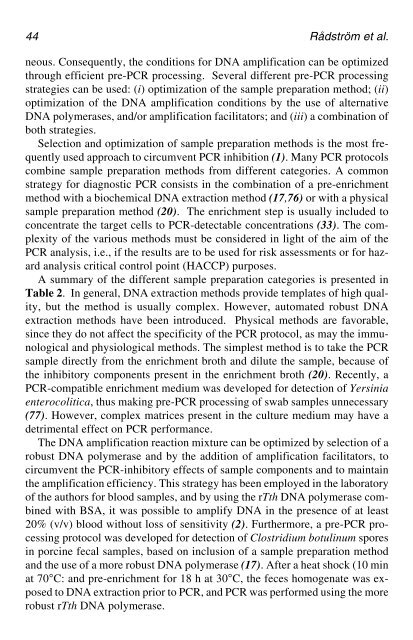PCR Detection of Microbial Pathogens PCR Detection of Microbial ...
PCR Detection of Microbial Pathogens PCR Detection of Microbial ...
PCR Detection of Microbial Pathogens PCR Detection of Microbial ...
Create successful ePaper yourself
Turn your PDF publications into a flip-book with our unique Google optimized e-Paper software.
44 Rådström et al.<br />
neous. Consequently, the conditions for DNA amplification can be optimized<br />
through efficient pre-<strong>PCR</strong> processing. Several different pre-<strong>PCR</strong> processing<br />
strategies can be used: (i) optimization <strong>of</strong> the sample preparation method; (ii)<br />
optimization <strong>of</strong> the DNA amplification conditions by the use <strong>of</strong> alternative<br />
DNA polymerases, and/or amplification facilitators; and (iii) a combination <strong>of</strong><br />
both strategies.<br />
Selection and optimization <strong>of</strong> sample preparation methods is the most frequently<br />
used approach to circumvent <strong>PCR</strong> inhibition (1). Many <strong>PCR</strong> protocols<br />
combine sample preparation methods from different categories. A common<br />
strategy for diagnostic <strong>PCR</strong> consists in the combination <strong>of</strong> a pre-enrichment<br />
method with a biochemical DNA extraction method (17,76) or with a physical<br />
sample preparation method (20). The enrichment step is usually included to<br />
concentrate the target cells to <strong>PCR</strong>-detectable concentrations (33). The complexity<br />
<strong>of</strong> the various methods must be considered in light <strong>of</strong> the aim <strong>of</strong> the<br />
<strong>PCR</strong> analysis, i.e., if the results are to be used for risk assessments or for hazard<br />
analysis critical control point (HACCP) purposes.<br />
A summary <strong>of</strong> the different sample preparation categories is presented in<br />
Table 2. In general, DNA extraction methods provide templates <strong>of</strong> high quality,<br />
but the method is usually complex. However, automated robust DNA<br />
extraction methods have been introduced. Physical methods are favorable,<br />
since they do not affect the specificity <strong>of</strong> the <strong>PCR</strong> protocol, as may the immunological<br />
and physiological methods. The simplest method is to take the <strong>PCR</strong><br />
sample directly from the enrichment broth and dilute the sample, because <strong>of</strong><br />
the inhibitory components present in the enrichment broth (20). Recently, a<br />
<strong>PCR</strong>-compatible enrichment medium was developed for detection <strong>of</strong> Yersinia<br />
enterocolitica, thus making pre-<strong>PCR</strong> processing <strong>of</strong> swab samples unnecessary<br />
(77). However, complex matrices present in the culture medium may have a<br />
detrimental effect on <strong>PCR</strong> performance.<br />
The DNA amplification reaction mixture can be optimized by selection <strong>of</strong> a<br />
robust DNA polymerase and by the addition <strong>of</strong> amplification facilitators, to<br />
circumvent the <strong>PCR</strong>-inhibitory effects <strong>of</strong> sample components and to maintain<br />
the amplification efficiency. This strategy has been employed in the laboratory<br />
<strong>of</strong> the authors for blood samples, and by using the rTth DNA polymerase combined<br />
with BSA, it was possible to amplify DNA in the presence <strong>of</strong> at least<br />
20% (v/v) blood without loss <strong>of</strong> sensitivity (2). Furthermore, a pre-<strong>PCR</strong> processing<br />
protocol was developed for detection <strong>of</strong> Clostridium botulinum spores<br />
in porcine fecal samples, based on inclusion <strong>of</strong> a sample preparation method<br />
and the use <strong>of</strong> a more robust DNA polymerase (17). After a heat shock (10 min<br />
at 70°C: and pre-enrichment for 18 h at 30°C, the feces homogenate was exposed<br />
to DNA extraction prior to <strong>PCR</strong>, and <strong>PCR</strong> was performed using the more<br />
robust rTth DNA polymerase.






